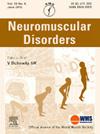123P The difficult path to diagnosis of the patient with spinal muscular atrophy
IF 2.7
4区 医学
Q2 CLINICAL NEUROLOGY
引用次数: 0
Abstract
News treatments make early diagnosis of spinal muscular atrophy (SMA) critical. The objective of this study is to analyse the different factors that influence delay in diagnosis. Patients with a molecular diagnosis of types I, II, and III SMA were included. Several parameters were studied, such as age at onset of first sign, what sign it was, and the time from recognition of first sign to confirmed diagnosis. Neurologists specialized in SMA conducted interviews, supported by the review of medical records when deemed necessary. A total of 112 patients were interviewed. SMA I n = 40, SMA II n = 48, SMA III n = 24. The median age in months at the time of reporting the first sign was SMA I: 1.5 (R: 0–7), SMA II: 9 (R: 2–20), SMA III: 18 (R: 8–180). In all subtypes, first signs were identified by parents from 75% to 85% of the times. The top-3 detected signs were: SMA I: hypotonia (38.5%), developmental delay (33.3%), feeding difficulties (17.9%); SMA II: inability to stand (23%), inability to walk unaided (23%), proximal weakness (23%); SMA III: frequent falls (50%), unsteady gait (20.8%), developmental delay (16.7%). The median time from first sign to first medical consultation was less than a month in all 3 types. The SMN genetic study was requested by the healthcare professional during the first consultation in 22.5% of SMA I patients, 16.7% of SMA II patients and in none of the SMA III patients. The median time in months, from first sign to confirmed molecular diagnosis in SMA I was: 2 (R: 0–11), in SMA II: 10 (R: 3–46), in SMA III: 31.5 (R: 4–288). There is a significant delay in SMA diagnosis mainly related to the absence of clinical suspicion. The delay is shorter in SMA I and longer in SMA III. Other factors include deficiencies in the health care system.
123P 诊断脊髓性肌萎缩症患者的艰难之路
新疗法使脊髓性肌萎缩症(SMA)的早期诊断变得至关重要。本研究旨在分析影响诊断延迟的不同因素。研究对象包括分子诊断为 I 型、II 型和 III 型 SMA 的患者。研究了多个参数,如首次出现体征时的年龄、是什么体征以及从发现首次体征到确诊的时间。SMA 专科神经科医生进行了访谈,必要时还查阅了病历。共对 112 名患者进行了访谈。SMA I 型 40 人,SMA II 型 48 人,SMA III 型 24 人。报告首发症状时的月龄中位数为:SMA I:1.5(R:0-7),SMA II:9(R:2-20),SMA III:18(R:8-180)。在所有亚型中,有 75% 至 85% 的首次征兆是由父母发现的。发现的前 3 个征兆是SMA I:肌张力低下(38.5%)、发育迟缓(33.3%)、喂养困难(17.9%);SMA II:无法站立(23%)、无法独立行走(23%)、近端无力(23%);SMA III:经常跌倒(50%)、步态不稳(20.8%)、发育迟缓(16.7%)。在所有三种类型中,从首次出现症状到首次就诊的中位时间均少于一个月。22.5% 的 I 型 SMA 患者、16.7% 的 II 型 SMA 患者和没有任何 III 型 SMA 患者在首次就诊时要求医护人员进行 SMN 遗传学检查。在 SMA I 期患者中,从首次出现症状到确诊为分子诊断的中位时间(以月为单位)为:2(R:0-11);在 SMA II 期患者中,为 10(R:3-46);在 SMA III 期患者中,为 31.5(R:4-288)。SMA 诊断存在明显延迟,这主要与缺乏临床怀疑有关。I 型 SMA 的延迟时间较短,III 型 SMA 的延迟时间较长。其他因素还包括医疗保健系统的缺陷。
本文章由计算机程序翻译,如有差异,请以英文原文为准。
求助全文
约1分钟内获得全文
求助全文
来源期刊

Neuromuscular Disorders
医学-临床神经学
CiteScore
4.60
自引率
3.60%
发文量
543
审稿时长
53 days
期刊介绍:
This international, multidisciplinary journal covers all aspects of neuromuscular disorders in childhood and adult life (including the muscular dystrophies, spinal muscular atrophies, hereditary neuropathies, congenital myopathies, myasthenias, myotonic syndromes, metabolic myopathies and inflammatory myopathies).
The Editors welcome original articles from all areas of the field:
• Clinical aspects, such as new clinical entities, case studies of interest, treatment, management and rehabilitation (including biomechanics, orthotic design and surgery).
• Basic scientific studies of relevance to the clinical syndromes, including advances in the fields of molecular biology and genetics.
• Studies of animal models relevant to the human diseases.
The journal is aimed at a wide range of clinicians, pathologists, associated paramedical professionals and clinical and basic scientists with an interest in the study of neuromuscular disorders.
 求助内容:
求助内容: 应助结果提醒方式:
应助结果提醒方式:


